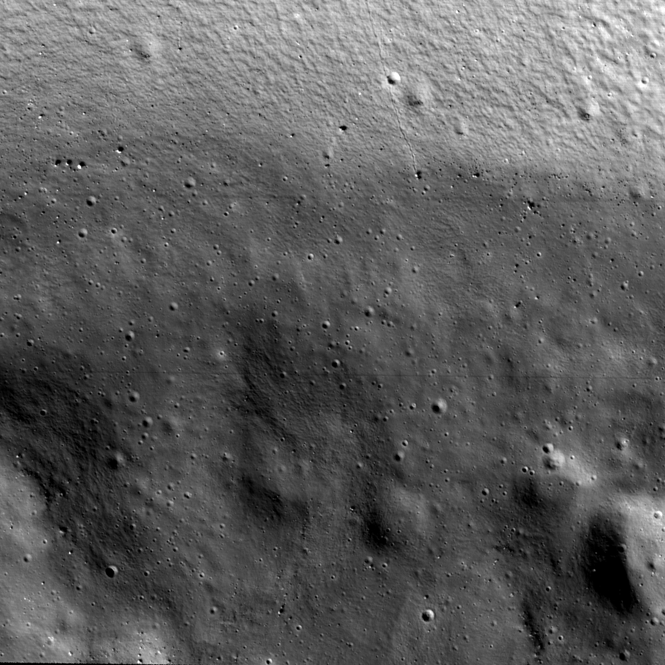
The far side of the moon has a certain mystique about it. It’s eternally out of view, never facing the Earth—which has earned it a misleading nickname, “the dark side,” as if sunlight never reaches its surface (it does). It’s the section of the moon we’ll never see for ourselves, not unless we hop on a spaceship and fly over there.
But the really mysterious parts of the moon aren’t on the far side. They’re at the poles, where the sun always hovers near the horizon. The lighting conditions create special circumstances: Hundreds of craters at the north and south poles never, ever receive direct sunlight, and so never feel the warmth of our star. They are, in astronomy parlance, permanently shadowed regions, and they’ve been that way, dark and frigid, for as long as billions of years. Astronauts have experienced the powdery surface of the moon up close, and space probes have mapped nearly every bit of the terrain from above—but none have peered into the depths of those pitch-black craters. With the right tools, astronomers hope, they’ll be able to peek inside and find something spectacular: water.
Not flowing water, of course—that’s not possible on the lunar surface—but ice crystals. Scientists believe that water has lurked on the moon for ages, delivered in its early history by comets and asteroids. (The same process is thought to have sprinkled our own planet with water.) The bombardment would have scattered icy particles across the surface, and particles that were exposed to the sun wouldn’t have lasted. But any bits of ice that might have tumbled into permanently shadowed regions would have been left untouched, sparkling in their freezing surroundings ever since. The environment is perfect; some sunless spots are colder than Pluto, says Prasun Mahanti, an Arizona State research scientist.
Scientists and engineers have probed permanently shadowed regions with several spacecraft missions over the years, Parvathy Prem, a planetary scientist at the Johns Hopkins Applied Physics Laboratory who studies the moon, told me. They’ve bounced radar waves off the surface to discern whether the hidden landscape was made of icy or rocky material. They’ve done the same with lasers, to get a sense of the hidden topography. In 2009, a spacecraft fired a projectile into the moon’s south pole and then detected, in the resulting plume of excavated material, the distinct signature of H20.
But no mission had targeted permanently shadowed regions with a photographer like ShadowCam, a new NASA camera that started orbiting the moon in December, aboard a Korean spacecraft. Each day, Mariah Heck, a research analyst assistant at Arizona State University, programs the aptly named ShadowCam to capture those sunless places. In the coming years, the team at ASU plans to photograph every known permanently shadowed region on the moon, revealing their interiors for the first time. The instrument has already provided a glimpse inside a crater near the moon’s south pole, which included a curious, previously unknown little furrow in the otherwise smooth soil—the path of a boulder that had rolled down the slope. It’s the kind of picture that even non-astronomers can immediately appreciate. “It’s powerful to finally see permanently shadowed regions at the wavelength that our eyes are sensitive to,” Prem said.

How do you illuminate a pitch-black hole on the moon? Not by dangling a flashlight from a spacecraft, as I first imagined. Like other cameras that have documented the lunar surface, ShadowCam relies on sunlight reflected by landscape features, such as crater walls. “It’s like you’re standing in the shadow of a tree, but you can still see what’s on the ground because of all the light reflecting off of the stuff around you,” Heck told me. ShadowCam is more than 200 times more sensitive than its predecessors, which means it’s better at basking in dim, ambient light to reveal details cloaked in darkness. “We’re seeing the moon in a way no one’s ever seen the moon before,” they said.
Scientists weren’t expecting to spot signs of water ice in ShadowCam’s first photo shoot, which covered a region that isn’t cold enough to sustain it. But there are many places left to check. Prem says that scientists are doing laboratory experiments on Earth to determine how much water ice must be present in lunar soil to be visible from space. “The quantities of ice that we’re likely to be able to see at the surface in visible light are likely to be very small,” she said—no skating rinks—but “if there’s enough ice, we should be able to see it.” The camera may even detect signs of other kinds of ice, such as nitrogen, ammonia, and methane. Or it could reveal that there’s no water ice at all. Scientists are hopeful that’s not the case, but “that’s always a possibility,” Mahanti, ShadowCam’s deputy principal investigator, said. “We really do not know what to expect.”
NASA is keen on getting close to permanently shadowed regions soon. The agency plans to dispatch to the south pole a new lunar rover next year, and a new generation of moonwalking astronauts later this decade, under the modern-day Artemis program, the successor to Apollo. The Apollo astronauts landed at sites along the moon’s sun-dappled equator, which were deemed easier and safer for their short missions. But the next generation of astronauts will arrive at the south pole. And if they can get their gloved hands on water ice, people could eventually return to the lunar surface with technology designed to extract its oxygen and hydrogen for use in life-support systems and even fuel, which would allow us to take up residence on the moon for weeks or months at a time.
The prospect of mining moon water is still closer to sci-fi than reality. For now, missions like ShadowCam will keep exploring from afar, adding texture to scientists’ daydreams about the moon’s most mysterious shadows. To Prem, the thought of illuminating them at last feels almost transcendent, as if we’re craning to experience something that wasn’t meant to be illuminated. “There does seem something kind of hallowed about somewhere that’s been dark and cold and unseen by human eyes for billions of years,” she said.







